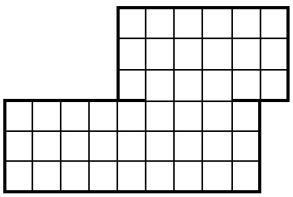 |
| ||||
Home Page
F.A.Qs
Statistical Charts
Past Contests
Scheduled Contests
Award Contest
| ||||||||||
| Online Judge | Problem Set | Authors | Online Contests | User | ||||||
|---|---|---|---|---|---|---|---|---|---|---|
| Web Board Home Page F.A.Qs Statistical Charts | Current Contest Past Contests Scheduled Contests Award Contest | |||||||||
|
Language: Square Count
Description Little Bobby Roberts, age 8, has been dragged to yet another museum by his parents. While they while away the hours studying Etruscan pottery and Warhol soup cans, Bobby must depend on himself for entertainment. Having a mathematical bent, he recently started counting all the square tiles on the floors of the museum. He soon realized that the tiles could be grouped into larger squares that needed to be added to the count. The problem became a bit more complicated when he started counting squares contained in multiple rooms, since some squares overlapped both rooms. For example, the two rooms shown below contain a total of 86 squares: 45 1 * 1 squares, 28 2 * 2 squares and 13 3 * 3 squares. (Note the opening between the two rooms is only 3 squares wide.)
 While this helped kill several days' worth of museum visits, it soon became rather tedious, so Bobby is now looking for a program to automate the counting process for him. Input Input will consist of multiple test cases. The first line of each case will be a positive integer n <= 1000 which will indicate the number of rooms in the museum. After this will be n lines, each containing a description of one room. Each room will be rectangular in shape and will be described by a line of the form
x1 y1 x2 y2 where (x1, y1) and (x2, y2) are opposing corner coordinates (integers) of the room. No two rooms will overlap, though they may share a side. If the shared side is of length m > 2, then a door of length m−2 exists between the two rooms, centered along the shared length. No square of any size will overlap more than two rooms. All x and y values will be <= 1, 000, 000. An input line of n = 0 terminates input and should not be processed. Output For each test case, output the total number of squares on a single line in the format shown below. All answers will fit within a 32-bit integer and cases are enumerated starting at 1. Sample Input 2 0 0 9 3 10 6 4 3 3 11 20 15 24 11 17 15 20 15 16 20 24 0 Sample Output Case 1: 86 Case 2: 152 Source |
[Submit] [Go Back] [Status] [Discuss]
All Rights Reserved 2003-2013 Ying Fuchen,Xu Pengcheng,Xie Di
Any problem, Please Contact Administrator